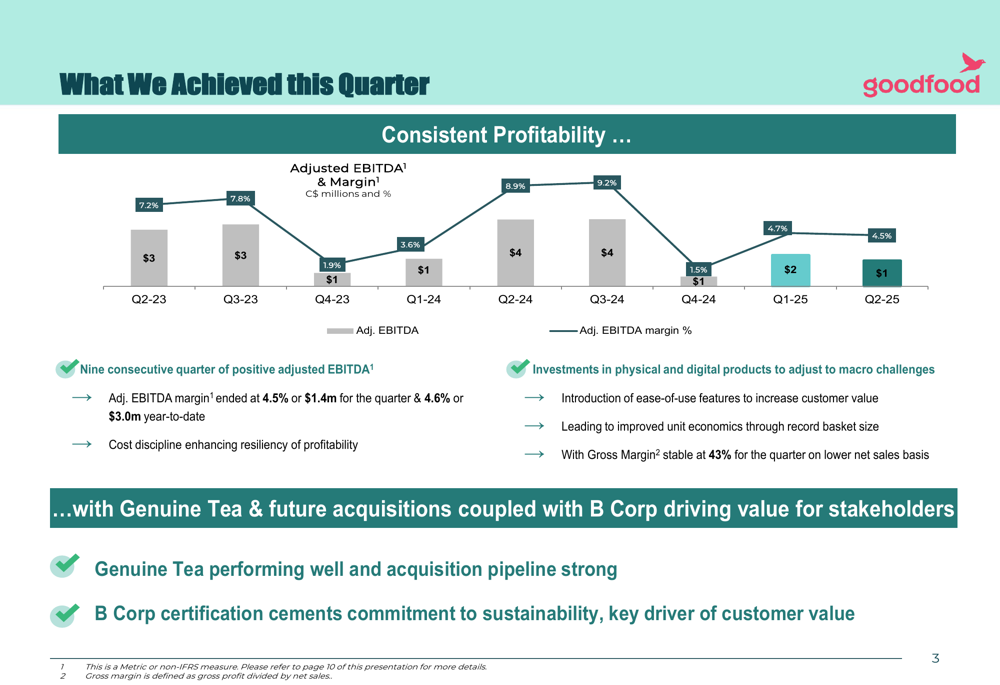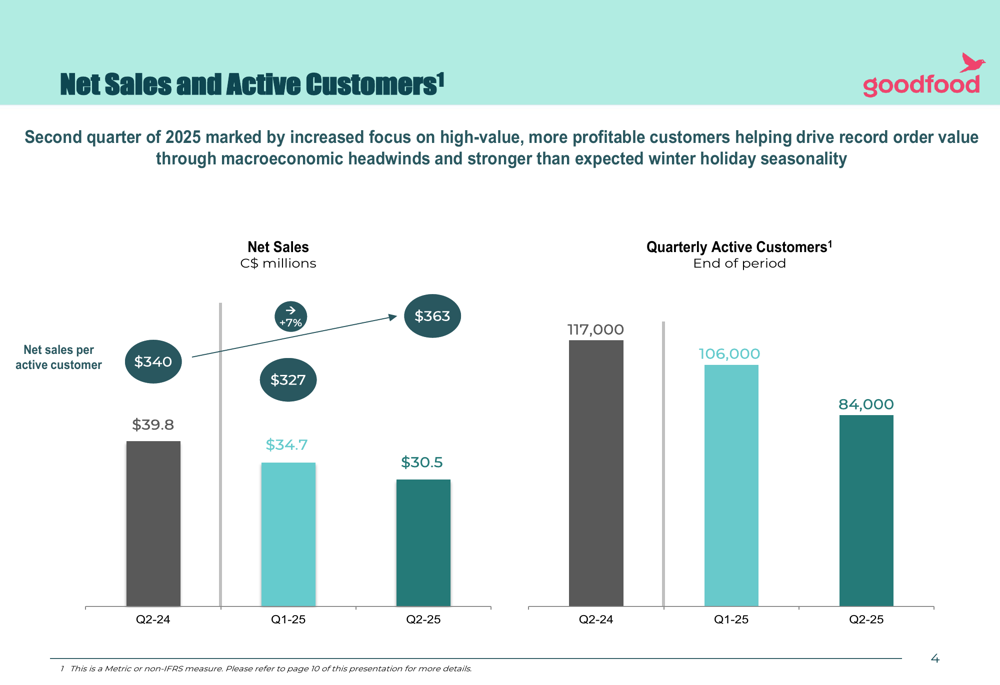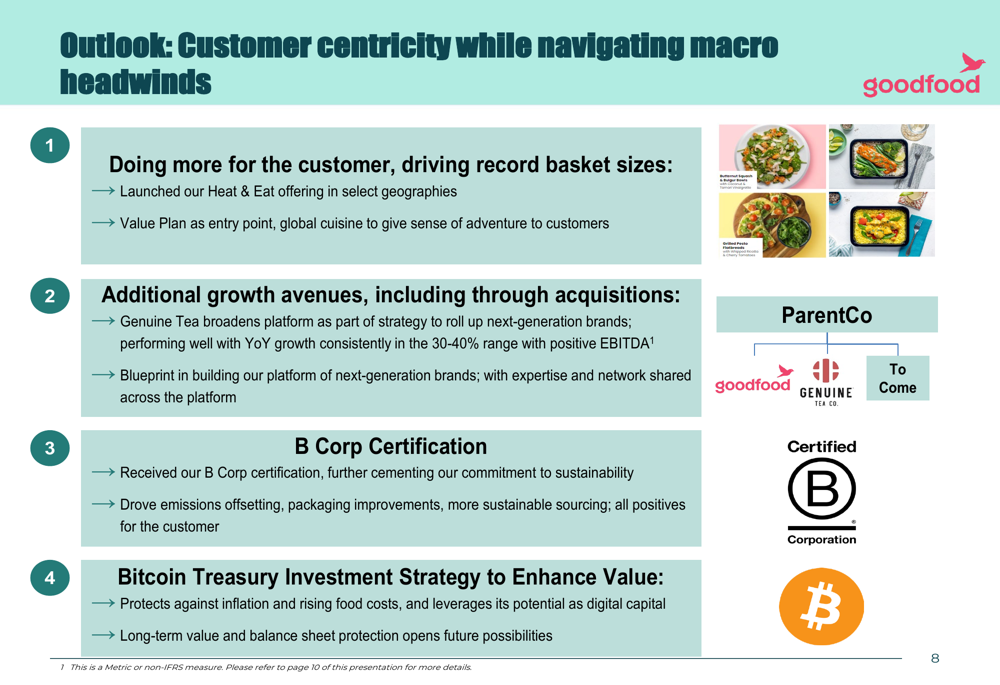Dimon says U.S. stocks facing higher risk of a serious fall - BBC
Introduction & Market Context
Goodfood Market Corp (TSX:FOOD) released its Q2 2025 earnings presentation on April 22, 2025, highlighting the company’s ninth consecutive quarter of positive adjusted EBITDA despite facing significant headwinds. The meal kit delivery service continues to navigate challenging macroeconomic conditions and stronger than expected winter holiday seasonality, which have impacted consumer spending and customer acquisition.
Trading at C$0.21 as of April 21, 2025, Goodfood shares remain near the lower end of their 52-week range of C$0.17-C$0.54, reflecting ongoing investor concerns about declining revenues and customer numbers despite maintained profitability.
Quarterly Performance Highlights
Goodfood reported adjusted EBITDA of C$1.4 million for Q2 2025, representing a margin of 4.5%. While this marks the ninth consecutive quarter of positive adjusted EBITDA, it reflects a significant decline from the C$3.5 million (8.9% margin) reported in the same quarter last year.
As shown in the following chart tracking adjusted EBITDA performance over multiple quarters, the company has maintained positive results despite fluctuations:

Net sales fell to C$30.5 million in Q2 2025, a 23% decrease from C$39.8 million in Q2 2024. This decline coincided with a shrinking customer base, with quarterly active customers dropping to 84,000 from 117,000 in the prior year period, as illustrated in the following charts:

The company attributed these declines to macroeconomic headwinds and a strategic focus on high-value, more profitable customers. Despite the revenue decline, Goodfood maintained a relatively stable gross margin of 42.6% compared to 43.0% in the same quarter last year, demonstrating the effectiveness of its cost discipline and operational improvements.
Detailed Financial Analysis
Goodfood’s comprehensive financial performance for Q2 2025 compared to Q2 2024 reveals several concerning trends despite the maintained profitability:

The company reported a net loss of C$2.4 million for Q2 2025, compared to net income of C$1.4 million in Q2 2024. Cash flows from operating activities turned negative at C$1.2 million, compared to a positive C$0.1 million in the prior year period. Similarly, adjusted free cash flow declined to negative C$1.5 million from positive C$0.3 million a year earlier.
The following charts illustrate these trends in gross profit, adjusted EBITDA, and net income:

Goodfood’s cash flow and leverage metrics also showed deterioration compared to the prior year:

The company’s net leverage ratio increased to 3.0x (post debentures repayment) from 2.4x in Q2 2024, indicating a weakening financial position despite the continued focus on profitability.
Strategic Initiatives
In response to these challenges, Goodfood outlined several strategic initiatives aimed at driving growth and improving customer value:

The company has launched its Heat & Eat offering in select geographies and introduced a Value Plan as an entry point for new customers. These initiatives, along with global cuisine options, have helped drive record basket sizes despite the declining customer base.
Goodfood is also pursuing growth through acquisitions, with its Genuine Tea acquisition reportedly performing well with year-over-year growth consistently in the 30-40% range and positive EBITDA. The company views this as part of a broader strategy to roll up next-generation brands and build a platform where expertise and network can be shared.
Additionally, Goodfood announced its B Corp certification, cementing its commitment to sustainability through emissions offsetting, packaging improvements, and more sustainable sourcing practices.
Perhaps most notably, the company revealed a Bitcoin treasury investment strategy, positioning it as a way to protect against inflation and rising food costs while leveraging Bitcoin’s potential as digital capital for long-term value and balance sheet protection.
Forward-Looking Statements
Looking ahead, Goodfood faces significant challenges in reversing the decline in its customer base and revenues. While the company has maintained profitability through cost discipline and operational improvements, the negative cash flow and increasing leverage ratio suggest potential financial pressures if current trends continue.
The strategic focus on high-value customers and new growth avenues, including acquisitions and the Bitcoin investment strategy, represents a pivot as the company seeks to navigate the challenging macroeconomic environment. However, these initiatives will need to translate into tangible financial improvements to restore investor confidence.
Goodfood’s ability to leverage its B Corp certification, expand its product offerings, and successfully integrate acquisitions like Genuine Tea will be critical factors in determining whether the company can return to growth while maintaining its hard-won profitability.
Full presentation:
This article was generated with the support of AI and reviewed by an editor. For more information see our T&C.
